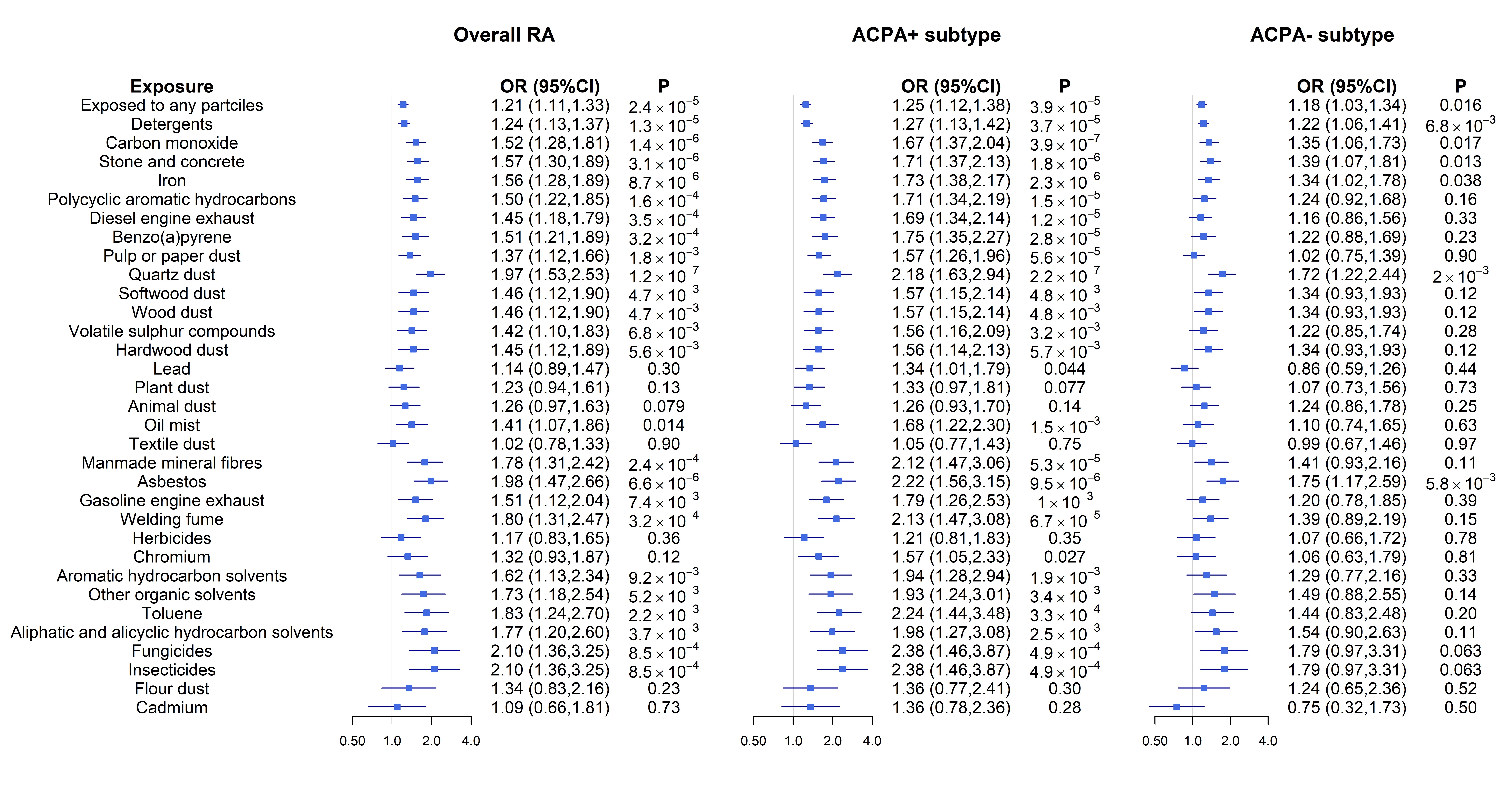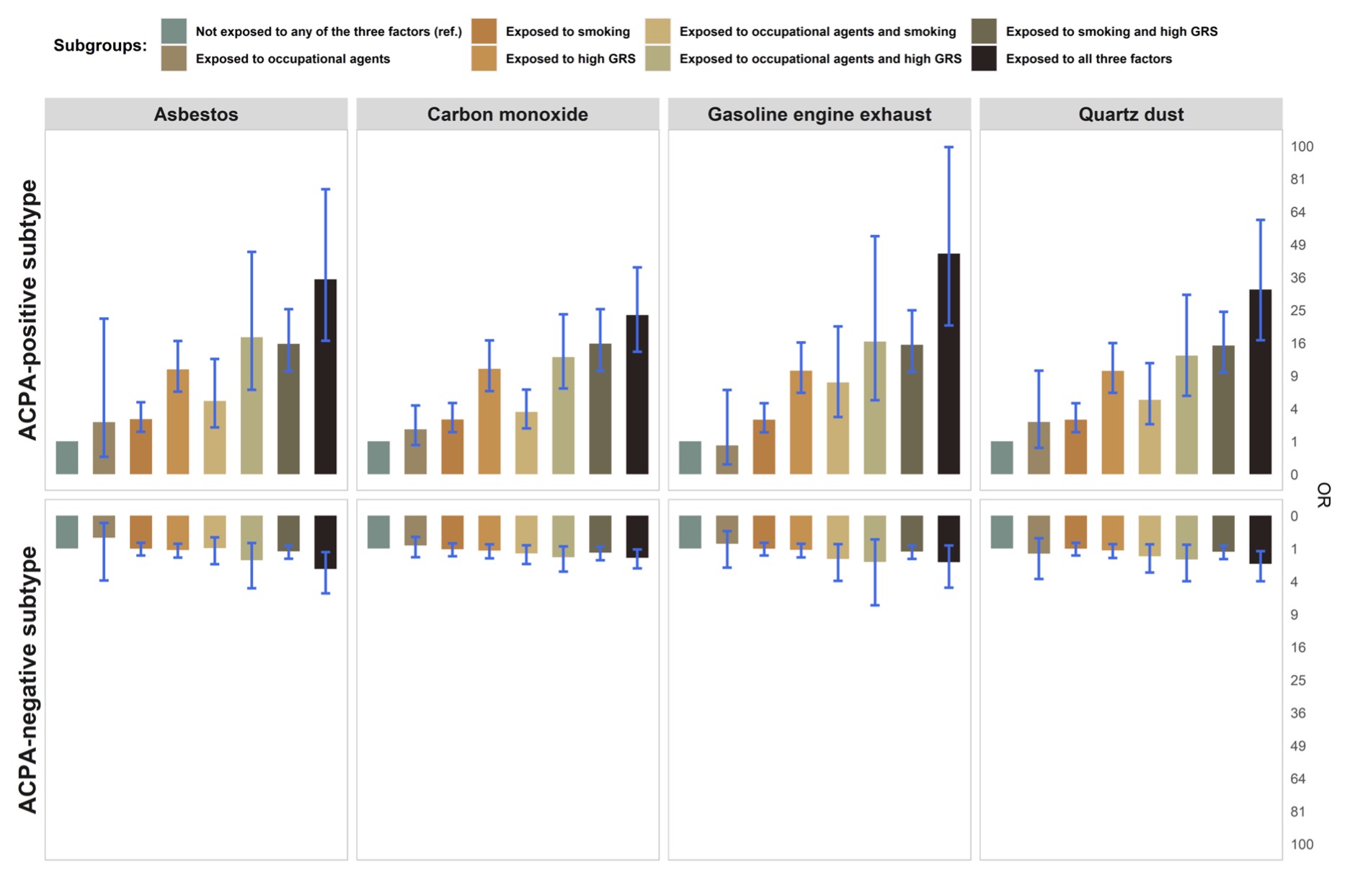Back
Poster Session B
Rheumatoid arthritis (RA)
Session: (0589–0628) RA – Etiology and Pathogenesis Poster
0601: Occupational Inhaled Agents Constitute Major Risk Factors for Rheumatoid Arthritis, Particularly in the Context of Genetic Predisposition and Smoking
Sunday, November 13, 2022
9:00 AM – 10:30 AM Eastern Time
Location: Virtual Poster Hall
- QL
Qianwen Liu, MBBS, MMSc
Karolinska Instututet
Stockholm, Sweden
Abstract Poster Presenter(s)
Bowen Tang1, Qianwen Liu2, Anna Ilar3, Pernilla Wiebert2, Sara Hägg1, Leonid Padyukov2, Lars Klareskog2, Lars Alfredsson2 and Xia Jiang2, 1Karolinska Institutet, Solna, Sweden, 2Karolinska Institutet, Stockholm, Sweden, 3The National Board of Health and Welfare, Stockholm, Sweden
Background/Purpose: The lung is recognized as a primary site in the induction of rheumatoid arthritis (RA). Our study aims to assess the effect of common occupational inhalable exposures on RA development and their interactions with smoking and RA-risk genes.
Methods: From 1996 to 2017, 4,033 incident RA cases and 6,485 controls matched on age, sex, and residential area were recruited from central and southern Sweden, all answering a self-administered questionnaire. For each participant, occupational history was retrieved, which together with information from a Swedish national job-exposure matrix allowed us to estimate the cumulative exposure to 32 different inhalable agents, taking prevalence and concentration into account. Approximately 3,400 cases and 2,800 controls had concomitant genetic data (genome-wide genotypes and human leucocyte antigen class II shared epitope (HLA-SE) genotypes). Two subtypes of RA were assessed based on the status of anti-citrullinated protein / peptide antibodies (ACPA), consisting of 2,642 ACPA-positive cases and 1,391 ACPA-negative cases.
Results: An increased risk of developing ACPA-positive RA was found for individuals ever exposed to any occupational inhalable agents (OR=1.25, 95%CI=1.12-1.38). The risk increased in a dose-response manner according to number of agents (Ptrend< 0.001) and duration of exposure (Ptrend< 0.001). When jointly considering occupational inhalable agents, smoking, and genetic risk score (GRS), a markedly elevated risk of developing ACPA-positive RA was observed among participants who were exposed to all three factors compared with those not exposed to any (OR=18.22, 95%CI=11.77-28.19). A significant interaction on the additive scale was found between occupational inhalable agents (ever exposed to any) and smoking for overall RA (attributable proportion due to interaction (AP)=0.19, 95%CI=0.08-0.31). A gene-environment interaction (with GRS or HLA-SE) was observed for a number of specific inhalable agents restricting to ACPA-positive RA, including quartz (GRS: AP=0.36, 95%CI=0.08-0.63; HLA-SE: AP=0.42, 95%CI=0.15-0.68), asbestos (GRS: AP=0.44, 95%CI=0.13-0.74; HLA-SE: AP=0.41, 95%CI=0.08-0.75), carbon monoxide (GRS: AP=0.23, 95%CI=0.01-0.45; HLA-SE: AP=0.29, 95%CI=0.07-0.51), fungicides (GRS: AP=0.56, 95%CI=0.19-0.93) and gasoline engine exhaust (GRS: AP=0.52, 95%CI=0.23-0.80; HLA-SE: AP=0.48, 95%CI=0.16-0.79). On the contrary, no indication of interaction was found in ACPA-negative subtype.
Conclusion: Occupational inhalable agents could act as important environmental triggers in RA development and interact with smoking and RA-risk genes leading to an excessive disease risk. These effects are specific to ACPA-positive RA. Preventive strategies aimed at reducing occupational hazards and smoking are warranted for reduction of the burden of RA, especially for those who are genetically vulnerable.
 Primary associations of individual occupational inhalable agents with RA.
Primary associations of individual occupational inhalable agents with RA.
<img src=https://www.abstractscorecard.com/uploads/Tasks/upload/17574/QHOPTGBB-1289321-2-ANY.jpg width=440 height=251.84074941452 border=0 style=border-style: none;>
 The combined effect of inhalable agents, smoking, and high genetic risk score with risk of RA. The results for five common occupational inhalable agents were shown in the figure, and the estimates were adjusted for age, sex, residential area, BMI, levels of education, alcohol drinking, and PCs 1-10.
The combined effect of inhalable agents, smoking, and high genetic risk score with risk of RA. The results for five common occupational inhalable agents were shown in the figure, and the estimates were adjusted for age, sex, residential area, BMI, levels of education, alcohol drinking, and PCs 1-10.
Disclosures: B. Tang, None; Q. Liu, None; A. Ilar, None; P. Wiebert, None; S. Hägg, None; L. Padyukov, None; L. Klareskog, None; L. Alfredsson, None; X. Jiang, None.
Background/Purpose: The lung is recognized as a primary site in the induction of rheumatoid arthritis (RA). Our study aims to assess the effect of common occupational inhalable exposures on RA development and their interactions with smoking and RA-risk genes.
Methods: From 1996 to 2017, 4,033 incident RA cases and 6,485 controls matched on age, sex, and residential area were recruited from central and southern Sweden, all answering a self-administered questionnaire. For each participant, occupational history was retrieved, which together with information from a Swedish national job-exposure matrix allowed us to estimate the cumulative exposure to 32 different inhalable agents, taking prevalence and concentration into account. Approximately 3,400 cases and 2,800 controls had concomitant genetic data (genome-wide genotypes and human leucocyte antigen class II shared epitope (HLA-SE) genotypes). Two subtypes of RA were assessed based on the status of anti-citrullinated protein / peptide antibodies (ACPA), consisting of 2,642 ACPA-positive cases and 1,391 ACPA-negative cases.
Results: An increased risk of developing ACPA-positive RA was found for individuals ever exposed to any occupational inhalable agents (OR=1.25, 95%CI=1.12-1.38). The risk increased in a dose-response manner according to number of agents (Ptrend< 0.001) and duration of exposure (Ptrend< 0.001). When jointly considering occupational inhalable agents, smoking, and genetic risk score (GRS), a markedly elevated risk of developing ACPA-positive RA was observed among participants who were exposed to all three factors compared with those not exposed to any (OR=18.22, 95%CI=11.77-28.19). A significant interaction on the additive scale was found between occupational inhalable agents (ever exposed to any) and smoking for overall RA (attributable proportion due to interaction (AP)=0.19, 95%CI=0.08-0.31). A gene-environment interaction (with GRS or HLA-SE) was observed for a number of specific inhalable agents restricting to ACPA-positive RA, including quartz (GRS: AP=0.36, 95%CI=0.08-0.63; HLA-SE: AP=0.42, 95%CI=0.15-0.68), asbestos (GRS: AP=0.44, 95%CI=0.13-0.74; HLA-SE: AP=0.41, 95%CI=0.08-0.75), carbon monoxide (GRS: AP=0.23, 95%CI=0.01-0.45; HLA-SE: AP=0.29, 95%CI=0.07-0.51), fungicides (GRS: AP=0.56, 95%CI=0.19-0.93) and gasoline engine exhaust (GRS: AP=0.52, 95%CI=0.23-0.80; HLA-SE: AP=0.48, 95%CI=0.16-0.79). On the contrary, no indication of interaction was found in ACPA-negative subtype.
Conclusion: Occupational inhalable agents could act as important environmental triggers in RA development and interact with smoking and RA-risk genes leading to an excessive disease risk. These effects are specific to ACPA-positive RA. Preventive strategies aimed at reducing occupational hazards and smoking are warranted for reduction of the burden of RA, especially for those who are genetically vulnerable.
 Primary associations of individual occupational inhalable agents with RA.
Primary associations of individual occupational inhalable agents with RA.<img src=https://www.abstractscorecard.com/uploads/Tasks/upload/17574/QHOPTGBB-1289321-2-ANY.jpg width=440 height=251.84074941452 border=0 style=border-style: none;>
Exposure-response relationship between occupational inhalable agents and RA. a) Participants were classified into exposed to 1, 2, 3, 4, or >=5 particles out of the 16 independent particles and compared to non-exposed group (not exposed to any of the 47 particles). b) Participants were classified into five subsets with exposure durations of 0-3.3, 3.3-8.0, 8.0-1.5, 1.5-24.0, 24.0-51.0 years (to any particles) and compared to non-exposed group (not exposed to any of the 47 particles). Results are shown for overall RA, as well as ACPA-positive and ACPA-negative subtypes. Estimates adjusted for age, sex, residential area, smoking, alcohol drinking, education, and BMI.
 The combined effect of inhalable agents, smoking, and high genetic risk score with risk of RA. The results for five common occupational inhalable agents were shown in the figure, and the estimates were adjusted for age, sex, residential area, BMI, levels of education, alcohol drinking, and PCs 1-10.
The combined effect of inhalable agents, smoking, and high genetic risk score with risk of RA. The results for five common occupational inhalable agents were shown in the figure, and the estimates were adjusted for age, sex, residential area, BMI, levels of education, alcohol drinking, and PCs 1-10. Disclosures: B. Tang, None; Q. Liu, None; A. Ilar, None; P. Wiebert, None; S. Hägg, None; L. Padyukov, None; L. Klareskog, None; L. Alfredsson, None; X. Jiang, None.

